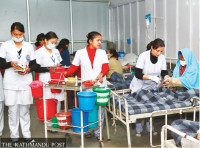Miscellaneous
Vertigo in the Valley
During the Maoist insurgency and the tenuous peace that followed, Kathmandu Valley’s population boomed like never before.
Aagat Ruchi Sapkota
During the Maoist insurgency and the tenuous peace that followed, Kathmandu Valley’s population boomed like never before. As a result, in last decade, the Valley’s urban sprawl spread out in every direction, real estate prices have soared and with open spaces becoming dearer, high-rises began to mushroom, redefining Kathmandu’s skyline. But then the 2015 earthquake changed all equations.
Now, two years after the earthquakes, the high-rise apartment industry’s road to recovery still seems uncertain. At the Valley’s many towering apartments, some tenants are sleeping soundly on the fifteenth floor, while many others are still reluctant to even set foot onto the premises of their former homes.
But with the earthquake’s two-year anniversary approaching, many developers seem satisfied meeting their recovery targets at this point of time. “People have started moving back to the apartments,” said Amrit Laxmi Tuladhar, head of sales department at CE Construction, which owns apartments like the Grande Towers in Dhapasi and the Retreat Apartments at Kupondole, “We may be even starting new projects in the same industry with improvisations.”
Similarly, Civil Homes Apartment and Sunrise Apartments have also seen residents return back. Many developers that the Post talked to, believe that they have reached their benchmark goals at this point of time, considering the circumstances.
“All the 22 families have now moved back in,” said Januka Tuladhar, who works at the sales department of Civil Homes Apartment in Dhapakhel, “In fact, we have even sold 13 of the remaining 19 apartments after the earthquake.”
Although the sales of high-rise apartments have staggered, few high-rise apartments like the one in Dhapakhel are still being bought as the population of the Valley continues to stay on the up.
CE’s bookings too have not dried up after the quake as they had initially anticipated. In surveys, CE Construct received feedback from many clients that they would rather live in high-rise buildings if the buildings are in prominent locations in town and are structurally sound.
The picture, however, is far from rosy all round. Many high-rise apartments continue to face uncertainty, as some structures are yet to be approved for retrofitting, while some projects have stalled altogether.
For instance, Civil Homes’ second high-rise apartment in Dhapakhel which had just begun construction before the earthquake has not made any further progress in the past two years. While the company is yet to make any formal announcement, many speculate that the project has been dropped.
Park View Horizon apartments of Basundhara Chowk, one of the more severely damaged high-rise structures in the Capital, is still awaiting approval from the government to begin retrofitting. The delay, according to Dan Bahadur Budhathoki, the president of the apartment’s victim’s association, has left the buildings’ former residents in a limbo.
“There are a lot of complications arising due to the delayed process,” said Budhathoki, “The government has locked the doors of the apartments but it is us who have to bear the brunt of the problem. The surrounding houses are complaining, insurance processes have halted and so much more.”
Other apartments also face the same uncertainty, with processes bottlenecked by a clear lack of direction. This may have triggered some panic but majority of apartment owners still continue to remain patient.
“It has been two years and the retrofitting has not even started,” said Ashish Khanal, who owns an apartment in Park View Horizon.
“We can’t deny that we have been psychologically affected,” said Khanal, “But we still have the confidence to move back in, if the buildings are approved for living by proper experts.” Khanal speculates that it may take a couple more years for the apartments to be ready but he is ready to wait as long as the engineers do strong structural retrofitting, and not just a cosmetic makeover.
Many other apartments that have been declared safe to move back into, however, are also not completely out of the woods yet, as now, many of them are struggling to find tenants; tenants who once flocked to high-rises. Some of the owners who lived in the now-safe apartments have now vacated them and long-standing tenants have also left, unable to bring themselves to live high in the skies once again. New tenants for these apartments, according to apartment owners, are hard to come by.
“Our tenant moved out immediately after the earthquake and it was empty for a long time until just recently,” said Abhinav Devkota, who owns an apartment on the 10th floor of the Grande Towers, “Personally, though, I do not have the confidence to live in that apartment.”
It is a sentiment echoed by many others who have lived in high-rises in the past. Nevertheless, in the Valley, where the population is ever growing and land is increasingly scarce, there are seemingly little options for developers than to expand vertically. A lot of developers that the Post talked to, however, confirm that townhouses are gaining popularity after the earthquake.
“The townhouses are now booming in comparison to apartments,” said Tuladhar of Civil Homes. Recently, there have been new housings sprawling in the outskirts of the Valley, in places like Tokha, Dhapakhel and Godavari because the central city is already running out of land.
“But it is not just an issue of the availability of land. Individual houses are not economically viable for a lot of people,” said Tuladhar of CE, “That is why we are developing small 5-7 storey apartments and plan to do so in the future as well.”
In the same vein, similar developers have started constructing relatively small apartments with better emergency staircases and no lifts. The modus operandi it appears is shifting towards developing viable alternatives, along with retrofitting and remodelling existing high-rise apartments to lure back residents and prospective tenants.
CE is even introducing a new project for a high-rise apartment. Their surveys indicate that Valley’s residents would rather face their fear of high-rises, if they are in central locations, rather than moving to the outskirts and commuting into the city. With a few other factors such as structural confidence and safety considered, CE intends to also evaluate the reception of their new building before determining how the company moves forward with regards to high-rise properties.
While similar developers are aware of this prospect, they remain sceptical about dipping their toes back into the market already. However, after analysing the reception of high-rise properties in the next couple of years, other developers are also open to idea of restarting high-rise projects.
“Maybe if consumers realise that apartments are actually safe and none of them suffered any vital structural damage during the quake, then they may be encouraged to live in apartments,” said Tuladhar, “But as of now, we are all waiting and watching.”




 10.12°C Kathmandu
10.12°C Kathmandu










